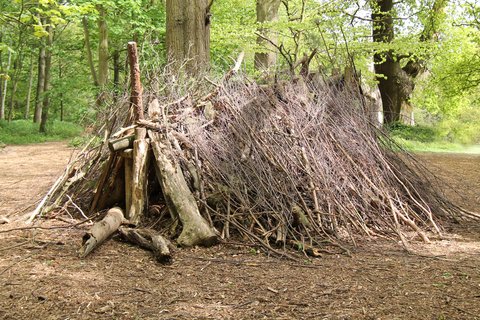The majority of people who perish in the wild, die from exposure. In the worst case scenario, you can be dead in only a few hours if you don’t get out of the elements. The order of survival in almost any situation is shelter, water, fire and food. Knowing how to build the best survival shelters under the conditions you’re in can save your life.
Snow Cave
Each winter, there are reports of people wandering out of bounds and getting lost in the snow. Typically, the ones who are found alive built snow caves. Snow is an excellent insulator and knowing how and where to build one can keep you from becoming hypothermic. A snow cave is almost always your best survival shelter in the winter.
RELATED: How to Build a Snow Cave
Debris Shelter
The other three seasons vary in temperature depending where you are and also vary in available survival shelter-building materials. In wooded mountainous areas where temperatures can dip below freezing, the debris hut survival shelter is by far the warmest. The key in building one is to customize it to your dimensions and pile the debris (pine needles, leaves etc.) on very thick. It should be about as thick as your arm length.
RELATED: How to Build a Debris Shelter
Desert Cave
Desert survival situations are a whole different ball game because of the lack of resources. Deserts can and do reach temperatures at night that can kill you if you’re not protected. The wind alone can severely dehydrate you and cause hypothermia. Consider the leeward side of a rocky outcropping for a survival shelter in this environment or better yet, a cave (just make sure you don’t have company). You should be able to find enough brush around to help insulate you. Again, try to make it small and as cozy as possible.
RELATED: How to Survive in the Desert
Tree Fall Shelter
Conserving energy is vital in any survival scenario. Almost all places have natural survival shelters if you look around. While a debris hut is a great choice, a lot of energy and time is needed to build one. Look for a fallen tree or depression where you need minimal materials. Sometimes it’s just a matter of laying a few branches over the top and piling on bows for insulation (the key ingredient).
Build a mattress or cot
Remember that you can have the coziest survival shelter around and still freeze if you don’t insulate yourself from the ground. The ground will suck heat out of you like a pool of leaches. Your mattress should be at least a foot thick (it will compress) and consist of the driest materials you can find. Many areas get damp at night so it’s important to seal yourself in as best as possible.
Keep it small
Survival shelters are often glamorized by images of tipi-like structures big enough for a whole family (and a nice little fire in the middle). The reality is that the less air space you have to heat, the more likely you’ll get through the night alive. Animals survive because they are well insulated and choose shelters that keep them out of the elements. Always prepare for the worst because sometimes the worst happens. A good shelter is paramount in any survival scenario.
© Daseaford | Dreamstime.com – Woodland Shelter.








